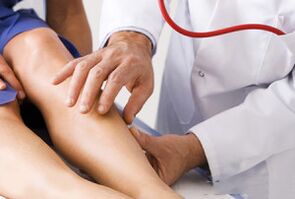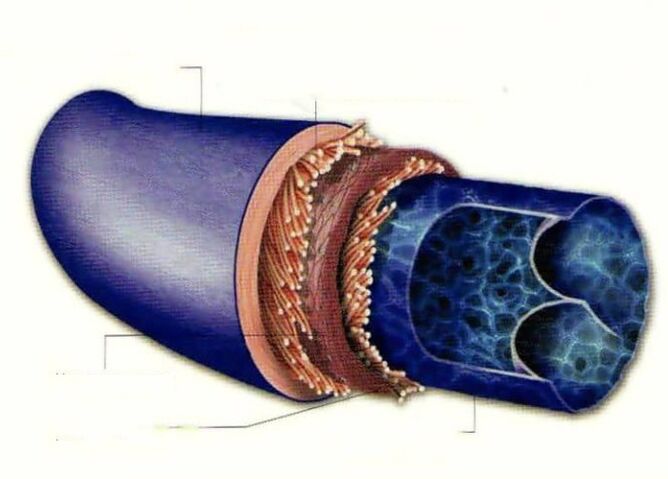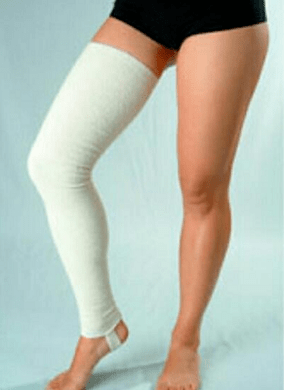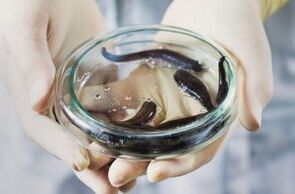
The article will be about the very definition of varicose veins, its symptoms and premises.And we will also talk about how to cure varicose vegetable expansion (depending on the place of its location) on the legs, varicose veins of the pelvic organs and not only.
Varicose veins are a disease of surface veins, in which valves of veins cease to function normally, as a result of which blood flow is impaired and deformation and thickening of the veins are being impaired.
More often you can find varicose veins on the legs.But there are other forms of this disease, such as the expansion of the veins of the pelvis or varicose veins of the esophagus.
You can notice that this disease, to some extent, is more susceptible to women, in view of their physiology.Also, according to statistics, the varicose veins more often than others can hurt tall and overweight people.
And yet, despite the prevalence of this disease, in most cases, surgical surgical treatment can be avoided.Of course, the most important aspect is the prevention of vein diseases, the timely detection of this disease in the initial and not yet neglected stages and a visit to a doctor who treats venous circulatory disorders (phlebologist).
With varicose veins, the symptoms of the disease will depend on which organ this disease appeared.
Varicosis on the legs can be characterized by the following symptoms: knotted swelling and tubercles appear in the place of veins;There is a pain syndrome and swelling that appears closer to the evening may occur.External signs are manifested in a change in skin color;A feeling of heat (or burning) may occur in the veins, and blood clots can form in the veins.
If there is a varicose extension of the lower extremities, then the following signs are added to the previous symptoms: convulsions sometimes appear in the legs (most often at night).In the later stages of the development of varicose veins or thrombophlebitis, the formation of trophic ulcers is possible;The skin on the legs is noticeably compacted.
Signs of varicose esophagus also have their own distinctive features.The symptoms of the manifestation of varicose expansion of the esophagus include the following factors:
- increase in hemorrhoidal veins;
- an increase in the spleen;
- expansion of the surface veins of the anterior abdominal wall;
- accumulation of free fluid in the abdominal cavity;
- black chair;
- vomiting with blood interspersed;
- expectorant with blood;
- esophageal-hungry bleeding (rarely).
The causes of varicose veins

The prerequisites for the occurrence of varicose veins include a genetic predisposition, diseases of the endocrine system, hormonal malfunctions or an incorrect lifestyle.The disease itself is not inherited directly.
Genetic causes are such pathologies in the structure of veins as insufficient equipment of veins with valves or
Anatomical deviations (incorrect number of casches or underdevelopment).
In women, varicose veins develop during periods associated with hormonal changes.These are such periods of life as a puberty, pregnancy and postpartum condition, as well as menopause.
It was also noted that varicose veins can develop when hormonal contraception or treatment with steroid drugs.
Varicose veins are also provoked by the incorrect way of life (smoking, abuse of alcoholic beverages, inability), and a work forcing a long time to stand or sit in the same position. What to do if the veins are painful on the legs, as well as find out the causes of venous diseases of the legs and methods of treating varicose veins, you can, by crossing the link.
Chronic or frequent inflammatory processes of the pelvic organs lead to varicose veins of the pelvis.And the cause of the disease of varicose veins of the esophagus may be diseases of the cardiovascular system, liver disease, pancreas and other abdominal organs.Next, I would like to talk about how to treat varicose veins.
Treatment of varicose veins with drugs
In order to return the tone of the veins and prevent the further development of the disease are prescribed drugs that have a tonic effect on the walls of the veins, reduce venous blood stagnation and the outflow of lymph, and improve blood microcirculation.
Home treatment

How to cure varicose veins on the legs without visiting the hospital?Very simple!Follow the following rules and soon you will forget about this ailment.While you are at home, be sure to bandage your legs with elastic bandages.Wear compression stockings and linen.During the period of exacerbation of varicose veins, in no case do not take a hot shower or bath, because it can only worsen your condition.
Try not to sit for a long time without changing your postures.In a sitting position, it is not advisable to put your leg on the leg.It is also not recommended to wear high -heeled shoes.Every day you can do short sessions of self -massage of the legs.For example, a very simple way to treat varicose veins at home with cabbage.
Cabbage compress
Take cabbage leaves, rinse well and put in the refrigerator for 24 hours.Make a ligation of the legs with these leaves at night for one month.Also, dressings can be made with gruel from fresh tomatoes.
You can also use ointment from varicose veins (for example, Troxevazin) and practice the treatment of varicose veins with herbs.There are alternative methods for the treatment of this ailment, such as hirudotherapy or laser therapy.
Treatment of varicose veins with leeches
As in the case of Veus diseases, hirudotherapy makes a significant contribution to the therapy of varicose diseases.It is noted that the saliva of leeches contains a natural anticoagulant - girudin.He also copes well with the task of coagulation and lower blood viscosity.It was noted that during therapy with the help of leeches, spasms of arteries disappear.

But this procedure is not recommended for persons who have anemia, reduced blood coagulation.People who have completed this procedure say that the leech bite is comparable to the burns from nettles.So there is no need to be afraid of hirudotherapy.Nowadays, the treatment of varicose veins is more often used, reviews for which are twofold (after all, the procedure has its cons and advantages).
Laser treatment
Treatment of varicose veins with laser The following advantages:
- quick rehabilitation period;
- almost complete lack of pain during the procedure;
- short time of the procedure;
- cosmetic effect (lack of scars);
- prolonged therapeutic effect;
The minuses of this procedure include the following factors:
- hematoma formation;
- impaired sensitivity;
- Blutings formation.
Treatment of varicose veins using a laser is carried out under the control of an ultrasound scanner.During the procedure, through a small puncture, the LED is passed into the vein cavity.And with a laser “brewed” the machine of the damaged vessel.
Media physical education for varicose veins of the pelvis (exercise therapy)
Varicose veins of the small pelvis are treated with conservative methods or surgical intervention. But in most cases, the treatment of varicose veins without surgery is still possible.I would also like to talk about how to treat varicose veins of the pelvis using physical exercises.
To get rid of the symptoms of the disease and prevent its progression, do the following exercises every day.
Exercise 1
Take the starting position of standing.Dismiss your hands to the sides.When inhalation, draw forward, trying to get to the floor when exhaling.Take the original position.
Repeat this exercise ten times in 3 approaches.
Exercise 2
Lie down on your back, bend both legs in your knees.On the exhale, raise the pelvic part of the body and return to the original state on exhalation.
Slowly repeat this exercise ten times.You can also perform the bicycle exercise.
Treatment of varicose veins of the esophagus
A doctor, treating varicose veins of the esophagus, will necessarily prescribe a strict diet to the patient.
Dietary nutrition
With varicose veins of the esophagus, the following products cannot be consumed:
- carbonated water;fatty and spicy foods;
- smoked food;Preparations;
- fried food;gross food (crackers, etc.);
- alcoholic drinks;juice;
- Raw vegetables and fruits.
But the products that are recommended to be consumed more often:
- low -fat vegetable soups;
- porridge;steamed fruits and vegetables;
- varieties of fish and meat of low fat content;
- not sharp cheeses;jelly;
- Milk, kefir, cottage cheese.
This form of varicose veins is better treated with surgery.
Surgical surgery
It is customary to carry out a port -cavalry and spansary anastomosis with the preservation or removal of the spleen, do the devascularization of the cardioisophageal department, bilateral vagotomy, cross the ligament of the gate and unpaired veins (operation of the tanner), sheathe or subsidize the buckets of the esophagus, the ligation of the spleen artery, the gastrootomy with firming the food of the food of the food and the food of the food of the foodstomach, transstoraceal esophagogaststomy.
A good effect is exerted by any mentioned operation, varicose veins passes.But with surgical intervention, there is always a risk of complications.Further, a few words about how to cure varicose veins with folk remedies.
Methods of traditional medicine
Traditional medicine also offers effective treatment of varicose veins without surgery.Here is one effective cure for varicose veins.
Garlic with honey
Take 250 grams of rumpled garlic, you need to add 350 grams of not thick flowing honey to it.The ingredients must be thoroughly mixed and set aside in a dark cool place for 7 days.You need to take this mixture for 1 tbsp.spoon 3 r/day (30 minutes before meals).The course of treatment should be two months.
Apple vinegar treatment
How to treat varicose veins on the legs with apple cider vinegar?In the morning and evening, you can rub your legs with apple cider vinegar.You can also use vinegar inside 2 teaspoons diluted in 250 grams of water 2-3 times a day.
